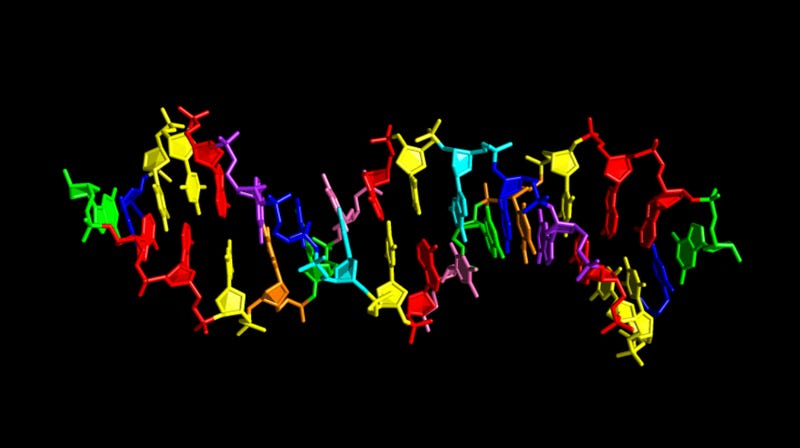 The structure of the new 8-base genetic system. The four naturally occurring bases are shown in green (G), red (A), blue (C), and yellow (T), while the synthetic bases are shown in cyan (B), pink (S), purple (P), and orange (Z). Image: Indiana University School of Medicine
The structure of the new 8-base genetic system. The four naturally occurring bases are shown in green (G), red (A), blue (C), and yellow (T), while the synthetic bases are shown in cyan (B), pink (S), purple (P), and orange (Z). Image: Indiana University School of Medicine
Conventional DNA is comprised of the familiar A, C, G, and T base pairs, but a newly created genetic system is packed with eight, thus doubling the number of letters normally found in self-replicating molecules. Intriguingly, the new system, dubbed “hachimoji,” could resemble the building blocks of extraterrestrial life.
New research published yesterday in Science describes the hachimoji, which means “eight letters” in Japanese. In addition to the conventional four base pairs, this genetic system has an extra four building blocks, dramatically increasingly the information density compared to regular DNA. The scientists behind the work, led by Steven Benner from the Foundation for Applied Molecular Evolution in Alachua, Florida, said the new system may be robust enough to support life, that is, to support the processes required for Darwinian self-replication.
To be clear, hachimoji is not an autonomously self-sustaining organism. Rather, it’s a model of an alternative genetic structure required to sustain self-replicating life. On Earth, RNA and DNA perform this function exclusively, but that’s not to say other variations don’t exist elsewhere in the cosmos. Indeed, astrobiologists will undoubtedly be interested in this research because it demonstrates another possible mechanism from which life could emerge, evolve, and complexify.
The authors of the study aren’t claiming that hachimojis exist elsewhere in the Universe, but “we can imagine parallel processes,” Andrew Ellington, a co-author of the new study and a synthetic biologist at the University of Texas, Austin, said in a statement. To which Benner added: “By carefully analyzing the roles of shape, size and structure in hachimoji DNA, this work expands our understanding of the types of molecules that might store information in extraterrestrial life on alien worlds.”
In normal RNA and DNA, combinations of four base pairs enable the storage and transmission of genetic information. These four building blocks of DNA, or nucleotides, consist of adenine, cytosine, guanine, and thymine, or more simply A, C, G, and T. In RNA, the T is replaced by U, which is uracil. The bases encode for amino acids, the fundamental building blocks of proteins.
Previous research managed to create synthetic DNA with four alternate letters in total and a system with two added base pairs for a total of six, but this is the first time scientists have gone all the way to eight.

Scientists Added Two New Letters to DNA's Code
If you’ve taken a science class, you’re likely aware that DNA is the body’s instruction manual. But …
Read more Read
The four new letters, P, B, Z and S, approximated the structures and functionality of regular DNA, according to the new study; P and B are purine-like in function, and Z and S are pyrimidine-like in function. In tests, the genetic system was shown to store and transfer information, effectively mimicking the molecular behavior of regular four-letter DNA. Importantly, hachimoji also met the Schrödinger requirements, which defines a Darwinian system of molecular-based evolution (and yes, that’s the same Erwin Schrödinger whose hypothetical quantum cat was both alive and dead). Schrödinger described four requirements of evolution: information storage, transmission, structural integrity, and a discernible, yet malleable, physical shape or structure.
“Hachimoji DNA can do everything that DNA does to support life,” noted a press release issued by the Foundation for Applied Molecular Evolution. “It pairs predictably, and rules predict its stability. Hachimoji DNA can be copied to make hachimoji RNA, able to direct protein synthesis. Hachimoji RNA can have a selectable phenotype [physical structure], in this [experiment], a green-fluorescent glow.”
Lori Glaze, acting director of NASA’s Planetary Science Division, was excited by the research, saying, “Life detection is an increasingly important goal of NASA’s planetary science missions, and this new work will help us to develop effective instruments and experiments that will expand the scope of what we look for,” according to an agency press statement.
“The research is significant because DNA has always been thought to be unique. For example, DNA is the only material for which we have the ability to design sequences that have predictable stability,” Floyd Romesberg, a geneticist at the Scripps Institute and co-author of the study involving the synthetic DNA with six base pairs, told Gizmodo. “And what Steve [Benner] has shown is that his new four letters satisfy every aspect of this predictable stability as well. While there have been hints that things other than the natural four letters of DNA might have this property, this work for the first time truly demonstrates it.”
Romesberg, who wasn’t involved with the new study, said an important application of an eight-letter alphabet is controlling molecular association, that is, the ability to program the configuration of the nucleotides. An eight-letter alphabet, he said, is inherently more specific than a four-letter alphabet.
“But this is useless if the stability of the eight letter alphabet is not predictable or programmable,” said Romesberg. “Because Steve has shown this, it opens up all sorts of new applications, which I am sure his lab and others will soon develop.”
Indeed, the new study, in addition to its astrobiological implications, could have a real-world impact as well. The authors say their findings could result in improved diagnostic equipment, environmental monitoring (such as the detection of dangerous viruses), alternatives to information storage, proteins with added amino acids, and innovative new medicines.
[Science]
Share This Story